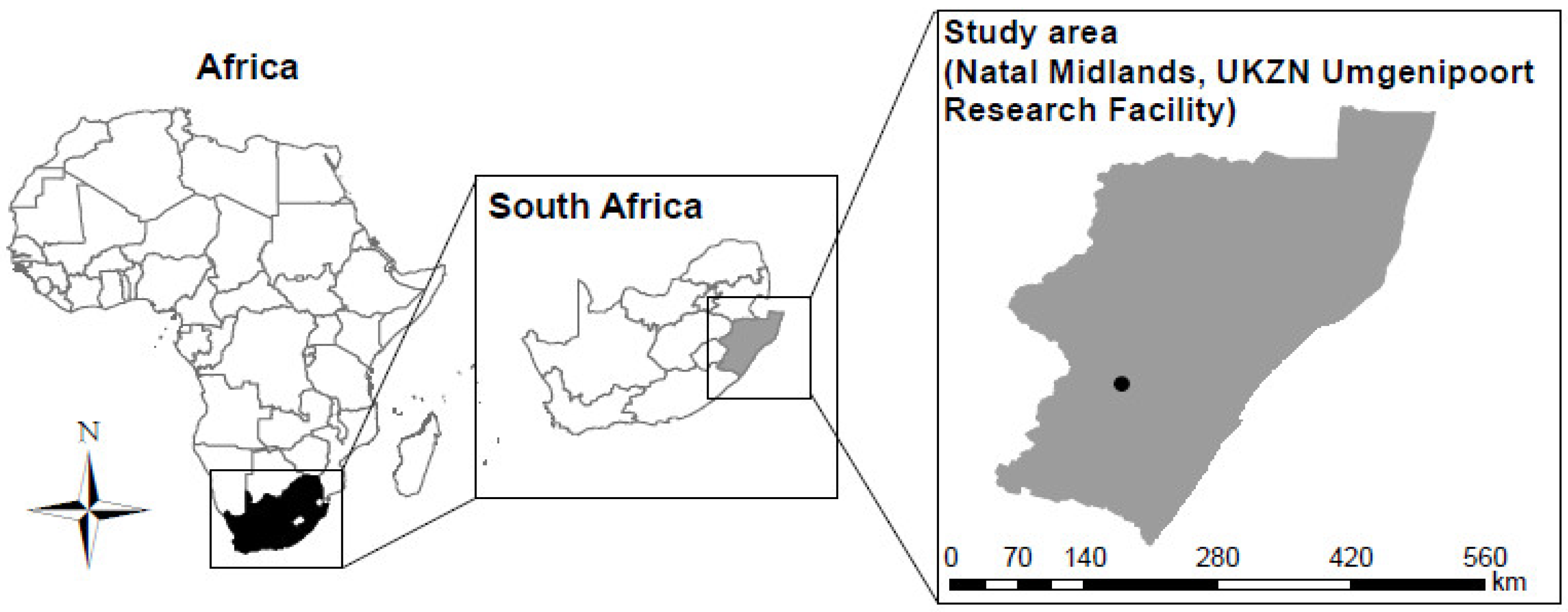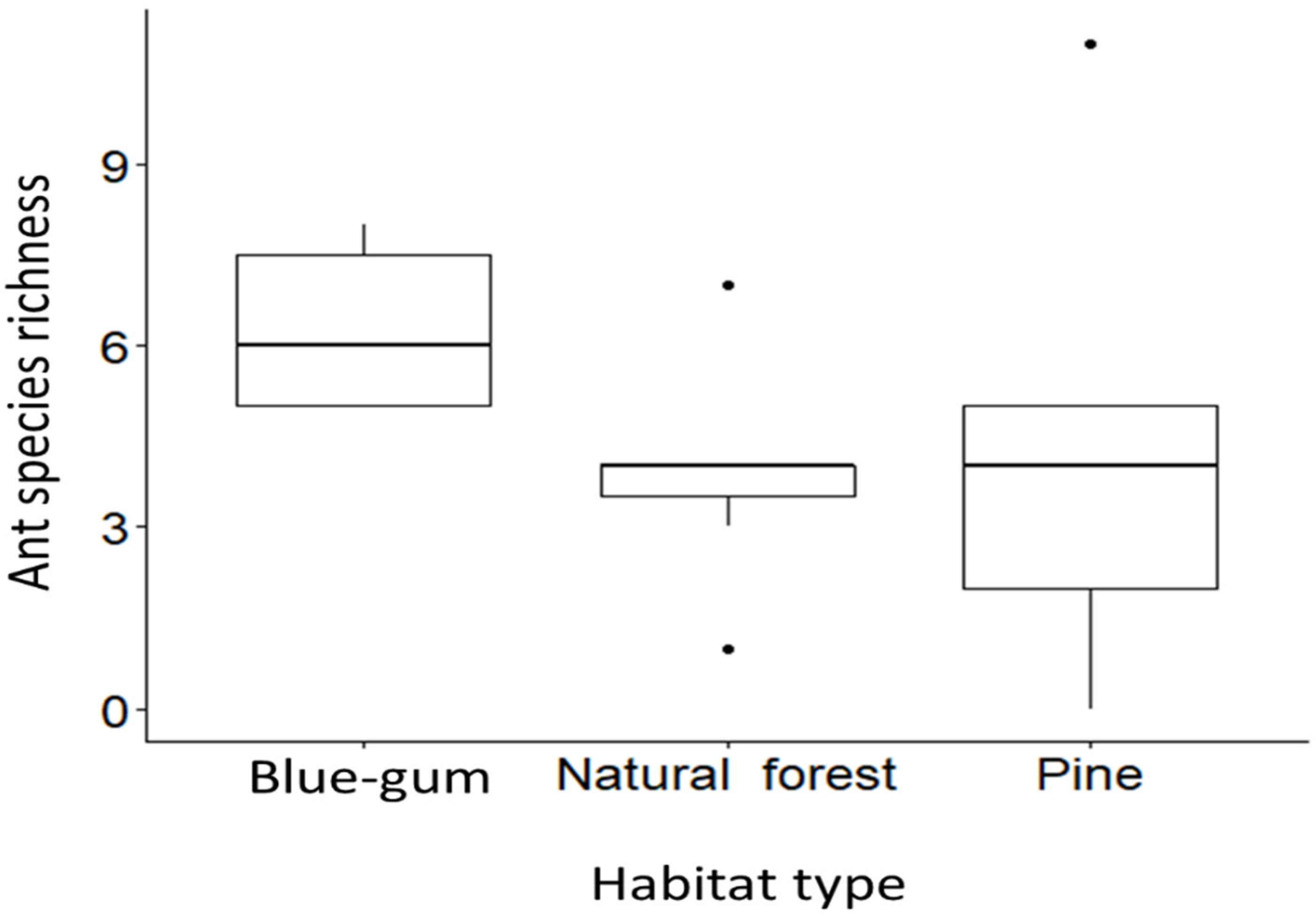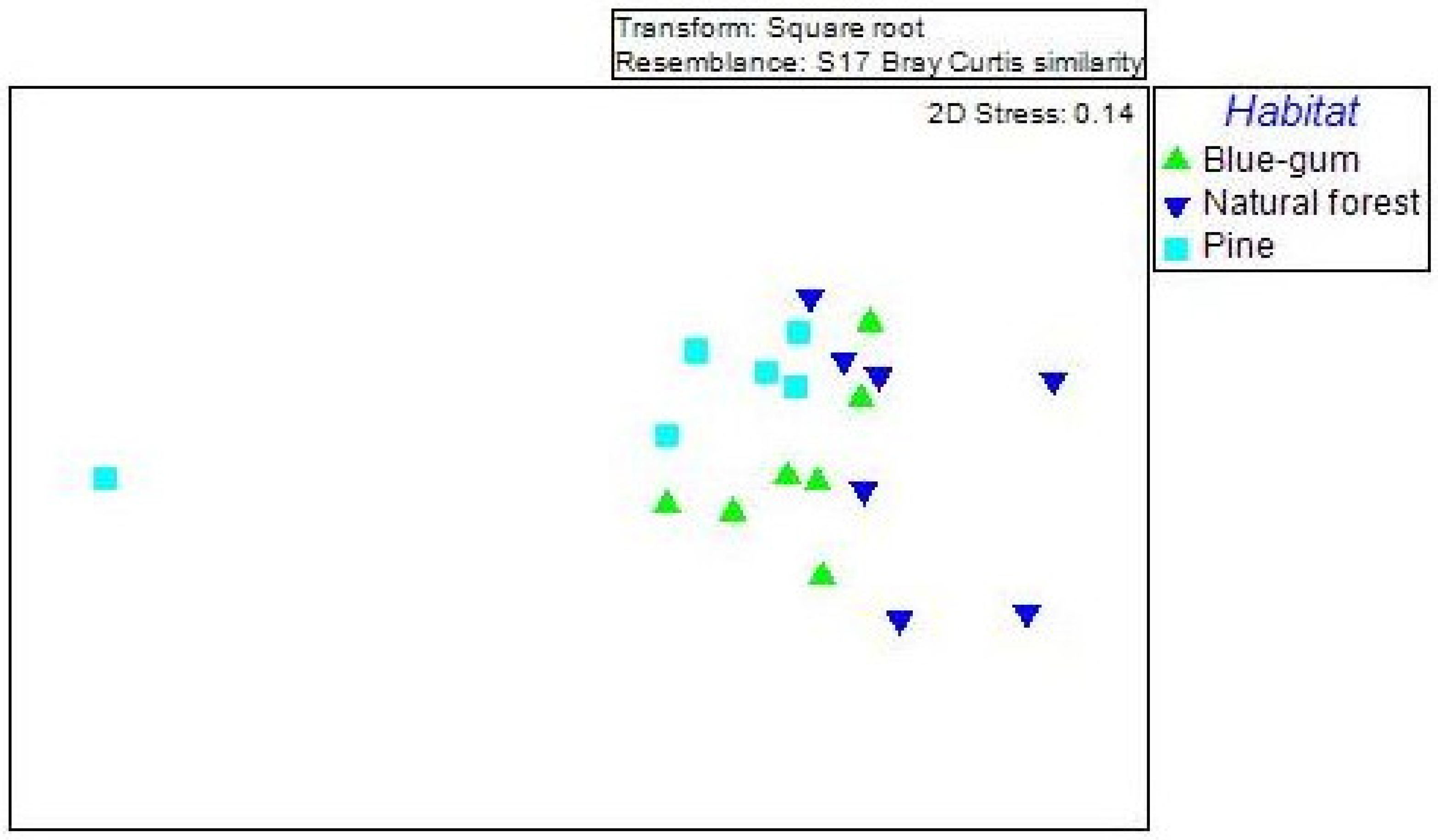Can Monoculture Timber Plantations Conserve More Ant Communities Than Adjacent Natural Forests?
Abstract
1. Introduction
2. Materials and Methods
2.1. Study Area
2.2. Ant Sampling
2.3. Statistical Analysis
3. Results
3.1. Sample Coverage for Species Diversity and Species Occurrence
3.2. Species Diversity
3.3. Assemblage Composition
3.4. Percentage Similarity between the Habitats
4. Discussion
4.1. Ant Species Diversity
4.2. Ant Species Assemblages
5. Conclusions
Supplementary Materials
Author Contributions
Funding
Institutional Review Board Statement
Informed Consent Statement
Data Availability Statement
Acknowledgments
Conflicts of Interest
References
- Armstrong, A.J.; Van Hensbergen, H.J. Impacts of Afforestation with Pines on Assemblages of Native Biota in South Africa. S. Afr. For. J. 1996, 175, 35–42. [Google Scholar] [CrossRef]
- Lovett, J. Our forests our future. Report of the World Commission on forests and sustainable development. Environ. Dev. Econ. 2001, 6, 151–153. [Google Scholar]
- Solar, R.R.D.C.; Barlow, J.; Andersen, A.N.; Schoereder, J.H.; Berenguer, E.; Ferreira, J.N.; Gardner, T.A. Biodiversity consequences of land-use change and forest disturbance in the Amazon: A multi-scale assessment using ant communities. Biol. Conserv. 2016, 197, 98–107. [Google Scholar] [CrossRef]
- Klunk, C.L.; Giehl, E.L.H.; Lopes, B.C.; Marcineiro, F.R.; Rosumek, F.B. Simple does not mean poor: Grasslands and forests harbor similar ant species richness and distinct composition in highlands of southern Brazil. Biota Neotrop. 2018, 18, e20170507. [Google Scholar] [CrossRef]
- Achury, R.; Suarez, A.V. Richness and Composition of Ground-dwelling Ants in Tropical Rainforest and Surrounding Landscapes in the Colombian Inter-Andean Valley. Neotropical Èntomol. 2018, 47, 731–741. [Google Scholar] [CrossRef]
- Kanowski, J.; Catterall, C.P.; Wardell-Johnson, G.W. Consequences of broadscale timber plantations for biodiversity in cleared rainforest landscapes of tropical and subtropical Australia. For. Ecol. Manag. 2005, 208, 359–372. [Google Scholar] [CrossRef]
- Stephens, S.S.; Wagner, M.R. Forest plantations and biodiversity: A fresh perspective. J. For. 2007, 105, 307–313. [Google Scholar]
- Lamb, D. Large-scale Ecological Restoration of Degraded Tropical Forest Lands: The Potential Role of Timber Plantations. Restor. Ecol. 1998, 6, 271–279. [Google Scholar] [CrossRef]
- Brockerhoff, E.G.; Jactel, H.; Parrotta, J.A.; Quine, C.P.; Sayer, J. Plantation forests and biodiversity: Oxymoron or opportunity? Biodivers. Conserv. 2008, 17, 925–951. [Google Scholar] [CrossRef]
- Magura, T.; Tóthmérész, B.; Elek, Z. Impacts of Leaf-litter Addition on Carabids in a Conifer Plantation. Biodivers. Conserv. 2005, 14, 475–491. [Google Scholar] [CrossRef]
- Bernadou, A.; Céréghino, R.; Barcet, H.; Combe, M.; Espadaler, X.; Fourcassié, V. Physical and land-cover variables influence ant functional groups and species diversity along elevational gradients. Landsc. Ecol. 2013, 28, 1387–1400. [Google Scholar] [CrossRef][Green Version]
- García-Martínez, M.A.; Martínez-Tlapa, D.L.; Pérez-Toledo, G.R.; Quiroz-Robledo, L.N.; Castaño-Meneses, G.; Laborde, J.; Valenzuela-González, J.E. Taxonomic, Species and Functional Group Diversity of Ants in a Tropical Anthropogenic Landscape. Trop. Conserv. Sci. 2015, 8, 1017–1032. [Google Scholar] [CrossRef]
- Andersen, A.N. Responses of ant communities to disturbance: Five principles for understanding the disturbance dynamics of a globally dominant faunal group. J. Anim. Ecol. 2019, 88, 350–362. [Google Scholar] [CrossRef] [PubMed]
- Andersen, A.N.; Penman, T.D.; Debas, N.; Houadria, M. Ant community responses to experimental fire and logging in a eucalypt forest of south-eastern Australia. For. Ecol. Manag. 2009, 258, 188–197. [Google Scholar] [CrossRef]
- Bestelmeyer, B.T. The trade-off between thermal tolerance and behavioural dominance in a subtropical South American ant community. J. Anim. Ecol. 2008, 69, 998–1009. [Google Scholar] [CrossRef]
- Sanders, N.J.; Lessard, J.-P.; Fitzpatrick, M.C.; Dunn, R.R. Temperature, but not productivity or geometry, predicts elevational diversity gradients in ants across spatial grains. Glob. Ecol. Biogeogr. 2007, 16, 640–649. [Google Scholar] [CrossRef]
- Dean, W.R.J.; Turner, J.S. Ants nesting under stones in the semi-arid Karoo, South Africa: Predator avoidance or temperature benefits? J. Arid Environ. 1991, 21, 59–69. [Google Scholar] [CrossRef]
- Munyai, T.C.; Foord, S.H. Ants on a mountain: Spatial, environmental and habitat associations along an altitudinal transect in a centre of endemism. J. Insect Conserv. 2012, 16, 677–695. [Google Scholar] [CrossRef]
- Tizón, R.; Wulff, J.P.; Peláez, D.V. The effect of increase in the temperature on the foraging of Acromyrmex lobicornis (Hymenoptera: Formicidae). Zoöl. Stud. 2014, 53, 40. [Google Scholar] [CrossRef]
- Colwell, R.K.; Coddington, J.A. Estimating terrestrial biodiversity through extrapolation. Philos. Trans. R. Soc. B Biol. Sci. 1994, 345, 101–118. [Google Scholar] [CrossRef]
- Samways, M.J.; Caldwell, P.M.; Osborn, R. Ground-living invertebrate assemblages in native, planted and invasive vegetation in South Africa. Agric. Ecosyst. Environ. 1996, 59, 19–32. [Google Scholar] [CrossRef]
- Robson, T.C.; Baker, A.C.; Murray, B.R. Differences in leaf-litter invertebrate assemblages between radiata pine plantations and neighbouring native eucalypt woodland. Austral Ecol. 2009, 34, 368–376. [Google Scholar] [CrossRef]
- Munyai, T.C.; Khoza, L.R.; Foord, S.H. Hidden just beneath our feet: Subterranean ants of the KwaZulu-Natal midlands. Afr. J. Ecol. 2021, 59, 554–560. [Google Scholar] [CrossRef]
- Mucina, L.; Rutherford, M. The Vegetation of South Africa, Lesotho and Swaziland; Strelitzia: Pretoria, South Africa, 2006; Volume 19. [Google Scholar]
- Bulcock, H.; Jewitt, G. Field data collection and analysis of canopy and litter interception in commercial forest plantations in the KwaZulu-Natal Midlands, South Africa. Hydrol. Earth Syst. Sci. 2012, 16, 3717–3728. [Google Scholar] [CrossRef]
- Mitchell, R.; Coutinho, T.; Steenkamp, E.; Herbert, M.; Wingfield, M. Future outlook forPinus patulain South Africa in the presence of the pitch canker fungus (Fusarium circinatum). South. For. J. For. Sci. 2012, 74, 203–210. [Google Scholar] [CrossRef]
- Peerbhay, K.Y.; Mutanga, O.; Ismail, R. Investigating the Capability of Few Strategically Placed Worldview-2 Multispectral Bands to Discriminate Forest Species in KwaZulu-Natal, South Africa. IEEE J. Sel. Top. Appl. Earth Obs. Remote Sens. 2014, 7, 307–316. [Google Scholar] [CrossRef]
- Munyai, T.C.; Foord, S.H. An inventory of epigeal ants of the western Soutpansberg Mountain Range, South Africa. Koedoe 2015, 57, 1244. [Google Scholar] [CrossRef]
- Botes, A.; McGeoch, M.A.; Robertson, H.G.; Van Niekerk, A.; Davids, H.P.; Chown, S.L. Ants, altitude and change in the northern Cape Floristic Region. J. Biogeogr. 2006, 33, 71–90. [Google Scholar] [CrossRef]
- Parr, C.L.; Robertson, H.G.; Biggs, H.C.; Chown, S.L. Response of African savanna ants to long-term fire regimes. J. Appl. Ecol. 2004, 41, 630–642. [Google Scholar] [CrossRef]
- Hohbein, R.R.; Conway, C.J. Pitfall traps: A review of methods for estimating arthropod abundance. Wildl. Soc. Bull. 2018, 42, 597–606. [Google Scholar] [CrossRef]
- Sheikh, A.H.; Ganaie, G.A.; Thomas, M.; Bhandari, R.; Rather, Y.A. Ant pitfall trap sampling: An overview. J. Entomol. Res. 2018, 42, 421–436. [Google Scholar] [CrossRef]
- Fisher, B.L.; Bolton, B. Ants of Africa and Madagascar: A Guide to the Genera; University of California Press: Oakland, CA, USA, 2016. [Google Scholar]
- Chao, A.; Ma, K.H.; Hsieh, T.C. iNEXT (iNterpolation and EXTrapolation) Online: Software for Interpolation and Extrapolation of Species Diversity. Available online: http://chao.stat.nthu.edu.tw/wordpress/software (accessed on 19 June 2021).
- Hammer, Ø.; Harper, D.A.T.; Ryan, P.D. Past: Paleontological Statistics Software Package for Education and Data Analysis. Palaeontol. Electron. 2001, 4, 9. [Google Scholar]
- Jost, L. Entropy and diversity. Oikos 2006, 113, 363–375. [Google Scholar] [CrossRef]
- Beck, J.; Schwanghart, W. Comparing measures of species diversity from incomplete inventories: An update. Methods Ecol. Evol. 2010, 1, 38–44. [Google Scholar] [CrossRef]
- Clarke, K.R.; Gorley, R.N. PRIMER v6: User Manual/Tutorial (Plymouth Routines in Multivariate Ecological Research); PRIMER-E: Plymouth, UK, 2006. [Google Scholar]
- Ratsirarson, H.; Robertson, H.G.; Picker, M.D.; van Noort, S. Indigenous forests versus exotic eucalypt and pine plantations: A comparison of leaf-litter invertebrate communities. Afr. Entomol. 2002, 10, 93–99. [Google Scholar]
- Ricketts, T.H. The Matrix Matters: Effective Isolation in Fragmented Landscapes. Am. Nat. 2001, 158, 87–99. [Google Scholar] [CrossRef]
- Yekwayo, I.; Pryke, J.S.; Roets, F.; Samways, M.J. Surrounding vegetation matters for arthropods of small, natural patches of indigenous forest. Insect Conserv. Divers. 2016, 9, 224–235. [Google Scholar] [CrossRef]
- Murray, B.R.; Baker, A.C.; Robson, T.C. Impacts of the Replacement of Native Woodland with Exotic Pine Plantations on Leaf-Litter Invertebrate Assemblages: A Test of a Novel Framework. Int. J. Ecol. 2009, 2009, 490395. [Google Scholar] [CrossRef]
- Corley, J.C.; DiMarco, R.D.; Fischbein, D.; Lantschner, M.V.; Martínez, A.S.; Masciocchi, M.; Mattiacci, A.; Paritsis, J.; Villacide, J.M. A synthesis on the impact of non-native conifer plantations on ant and beetle diversity in north-western Patagonia. South. For. J. For. Sci. 2018, 80, 285–291. [Google Scholar] [CrossRef]
- Eckert, M.; Gaigher, R.; Pryke, J.S.; Samways, M.J. Rapid recovery of soil arthropod assemblages after exotic plantation tree removal from hydromorphic soils in a grassland-timber production mosaic. Restor. Ecol. 2019, 27, 1357–1368. [Google Scholar] [CrossRef]
- Riedel, J.; Dorn, S.; Brand, G.; Barrios, H.; Mody, K. Effects of ants on arthropod assemblages of a native timber tree in a tropical reforestation plantation. J. Appl. Entomol. 2012, 137, 418–428. [Google Scholar] [CrossRef]
- Corley, J.; Sackmann, P.; Rusch, V.; Bettinelli, J.; Paritsis, J. Effects of pine silviculture on the ant assemblages (Hymenoptera: Formicidae) of the Patagonian steppe. For. Ecol. Manag. 2006, 222, 162–166. [Google Scholar] [CrossRef]
- Stephens, S.S.; Bosu, P.P.; Wager, M.R. Effect of overstory tree species diversity and composition on ground foraging ants (Hymenoptera: Formicidae) in timber plantations in Ghana. Int. J. Biodivers. Sci. Ecosyst. Serv. Manag. 2016, 12, 96–107. [Google Scholar] [CrossRef]
- Budiaman, A.; Haneda, N.F.; Nugraha, A.I.; Haikal, F. Impacts of Clear Cutting on Diversity of Ground Ants (Hymenoptera: Formicidae) in Pine Plantation Forest in Sukabumi Forest Management Unit, West Java. J. Manaj. Hutan Trop. 2021, 27, 42–49. [Google Scholar] [CrossRef]
- Burghouts, T.; Ernsting, G.; Korthals, G.; De Vries, T.; Vries, T.D. Litterfall, leaf litter decomposition and litter invertebrates in primary and selectively logged dipterocarp forest in Sabah, Malaysia. Philos. Trans. R. Soc. B Biol. Sci. 1992, 335, 407–416. [Google Scholar] [CrossRef]
- Georgiev, K.B.; Beudert, B.; Bässler, C.; Feldhaar, H.; Heibl, C.; Karasch, P.; Müller, J.; Perlík, M.; Weiss, I.; Thorn, S. Forest disturbance and salvage logging have neutral long-term effects on drinking water quality but alter biodiversity. For. Ecol. Manag. 2021, 495, 119354. [Google Scholar] [CrossRef]
- Grodsky, S.M.; Campbell, J.W.; Fritts, S.R.; Wigley, T.B.; Moorman, C.E. Variable responses of non-native and native ants to coarse woody debris removal following forest bioenergy harvests. For. Ecol. Manag. 2018, 427, 414–422. [Google Scholar] [CrossRef]
- Van Hengstum, T.; Hooftman, D.A.P.; Oostermeijer, J.G.B.; Van Tienderen, P.H. Impact of plant invasions on local arthropod communities: A meta-analysis. J. Ecol. 2014, 102, 4–11. [Google Scholar] [CrossRef]
- Foitzik, S.; Heinze, J.; Oberstadt, B.; Herbers, J.M. Mate guarding and alternative reproductive tactics in the ant Hypoponera opacior. Anim. Behav. 2002, 63, 597–604. [Google Scholar] [CrossRef]
- Borowiec, M.L. Generic revision of the ant subfamily Dorylinae (Hymenoptera, Formicidae). ZooKeys 2016, 608, 1–280. [Google Scholar] [CrossRef]
- Ramos, C.S.; Bellocq, M.I.; Paris, C.I.; Filloy, J. Environmental drivers of ant species richness and composition across the Argentine Pampas grassland. Austral Ecol. 2018, 43, 424–434. [Google Scholar] [CrossRef]
- Samways, M.J. Land Forms and Winter Habitat Refugia in the Conservation of Montane Grasshoppers in Southern Africa. Conserv. Biol. 1990, 4, 375–382. [Google Scholar] [CrossRef]
- Stuble, K.L.; Pelini, S.L.; Diamond, S.E.; Fowler, D.A.; Dunn, R.R.; Sanders, N.J. Foraging by forest ants under experimental climatic warming: A test at two sites. Ecol. Evol. 2013, 3, 482–491. [Google Scholar] [CrossRef] [PubMed]
- Kaspari, M.; O’Donnell, S.; Kercher, J.R. Energy, Density, and Constraints to Species Richness: Ant Assemblages along a Productivity Gradient. Am. Nat. 2000, 155, 280–293. [Google Scholar] [CrossRef] [PubMed]




| Habitat Types | Sobs | Species Occurrence | Sample Coverage |
|---|---|---|---|
| Blue gum | 19 | 44 | 0.967 |
| Natural forest | 14 | 27 | 0.950 |
| Pine | 14 | 29 | 0.931 |
| Habitat Type | Species Richness ± SD | Shannon–Wiener Diversity Index (H’) | Evenness | Effective Number of Species |
|---|---|---|---|---|
| Blue gum | 6.29 ± 1.38 | 2.38 | 0.57 | 11 |
| Natural Forest | 3.86 ± 1.77 | 1.96 | 0.51 | 7 |
| Pine | 4.14 ± 3.58 | 2.31 | 0.72 | 10 |
| Groups | R Statistic | Significance Level |
|---|---|---|
| Blue gum, Natural forest | 0.11 | 0.13 |
| Blue gum, Pine | 0.17 | 0.06 |
| Natural forest, Pine | 0.14 | 0.08 |
| Habitat Type Combinations | Species | Diss/SD Ratio |
|---|---|---|
| BG & NF | Hypoponera UKZN_03 | 0.77 |
| Lepisiota UKZN_08 (crinita gp.) | 0.77 | |
| BG & PN | Tetramorium UKZN_03 (setigerum gp.) | 0.99 |
| Monomorium UKZN_10 | 0.97 | |
| NF & PN | Solenopsis UKZN_03 | 0.98 |
| Monomorium UKZN_10 | 0.91 |
Publisher’s Note: MDPI stays neutral with regard to jurisdictional claims in published maps and institutional affiliations. |
© 2022 by the authors. Licensee MDPI, Basel, Switzerland. This article is an open access article distributed under the terms and conditions of the Creative Commons Attribution (CC BY) license (https://creativecommons.org/licenses/by/4.0/).
Share and Cite
Mthimunye, T.A.; Munyai, T.C. Can Monoculture Timber Plantations Conserve More Ant Communities Than Adjacent Natural Forests? Diversity 2022, 14, 430. https://doi.org/10.3390/d14060430
Mthimunye TA, Munyai TC. Can Monoculture Timber Plantations Conserve More Ant Communities Than Adjacent Natural Forests? Diversity. 2022; 14(6):430. https://doi.org/10.3390/d14060430
Chicago/Turabian StyleMthimunye, Thembekile A., and Thinandavha C. Munyai. 2022. "Can Monoculture Timber Plantations Conserve More Ant Communities Than Adjacent Natural Forests?" Diversity 14, no. 6: 430. https://doi.org/10.3390/d14060430
APA StyleMthimunye, T. A., & Munyai, T. C. (2022). Can Monoculture Timber Plantations Conserve More Ant Communities Than Adjacent Natural Forests? Diversity, 14(6), 430. https://doi.org/10.3390/d14060430






